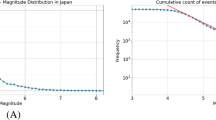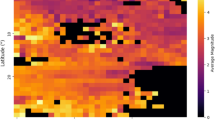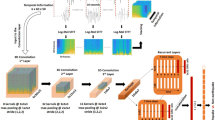Abstract
Timely estimation of earthquake magnitude plays a crucial role in the early warning systems for earthquakes. Despite the inherent danger associated with earthquake energy, earthquake research necessitates extensive parameter estimation and predictive techniques to account for uncertain trends in earthquake waveforms when determining earthquake magnitudes using a single station. This study introduces an effective solution to tackle the issue through the automatic magnitude deep network (AMagDN) model. The proposed model includes long short-term memory (LSTM), a bidirectional LSTM, an autocorrelation attention mechanism, and a machine learning block that can capture detailed information from the seismic waveform recorded during an earthquake. The unique feature of this model is the use of multivariate time series waveforms derived from recorded accelerograms specifically tailored to their energy significance with magnitude and seven fusion tabular parameters involving source and geospatial features. The proposed model’s training, validation and testing are done using independent 15014, 1287 and 3448 records maintained by the Kyoshin network, Japan, for moderate to great impact earthquakes between 5.5 and 8.0 (\(M_\textrm{JMA}\)). A comparative study shows that the proposed model outperforms recent state-of-the-art models and common linear relations, reducing mean absolute prediction error by 40% from the second-best model. The multi-stations data are also used for successfully forecasting the magnitudes of two significant earthquakes of 7.7 and 7.3 magnitude (\(M_\textrm{JMA}\)) using the proposed model. The reliable prediction capabilities of the proposed model for both single and multi-station data clearly demonstrate its utility in reducing earthquake hazards.







Similar content being viewed by others
Explore related subjects
Discover the latest articles and news from researchers in related subjects, suggested using machine learning.Data availability
The datasets generated during and/or analyzed during the current study are available from the corresponding author on reasonable request.
References
Cofre A, Marin M, Pino OV, Galleguillos N, Riquelme S, Barrientos SE, Yoma NB (2022) End-to-end lstm-based earthquake magnitude estimation with a single station. IEEE Geosci Remote Sens Lett 19:1–5. https://doi.org/10.1109/LGRS.2022.3175108
Cremen G, Galasso C (2020) Earthquake early warning: recent advances and perspectives. Earth Sci Rev 205:103184. https://doi.org/10.1016/j.earscirev.2020.103184
Festa G, Picozzi M, Alessandro C, Colombelli S, Cattaneo M, Chiaraluce L, Elia L, Martino C, Marzorati S, Supino M, Zollo A (2017) Performance of earthquake early warning systems during the major events of the 2016–2017 central Italy seismic sequence. Seismol Res Lett. https://doi.org/10.1785/0220170150
Berhich A, Belouadha FZ, Kabbaj MI (2023) An attention-based lstm network for large earthquake prediction. Soil Dyn Earthq Eng 165:107663. https://doi.org/10.1016/j.soildyn.2022.10766
Wu Y, Zhao L (2006) Magnitude estimation using the first three seconds p-wave amplitude in earthquake early warning. Geophys Res Lett. https://doi.org/10.1029/2006GL026871
Wu Y, Kanamori H (2005) Rapid assessment of damage potential of earthquakes in Taiwan from the beginning of p waves. Bull Seismol Soc Am 95:1181–1185. https://doi.org/10.1785/0120040193
Wu Y, Kanamori H (2005) Experiment on an onsite early warning method for the Taiwan early warning system. Bull Seismol Soc Am 95:347–353. https://doi.org/10.1785/0120040097
Wu Y, Yen H, Zhao L, Huang B, Liang W (2006) Magnitude determination using initial p waves: a single-station approach. Geophys Res Lett 33:05306. https://doi.org/10.1029/2005GL025395
Kanamori H (2005) Real-time seismology and earthquake damage mitigation. Annu Rev Earth Planet Sci 33:195–214. https://doi.org/10.1146/annurev.earth.33.092203.122626
Joshi A, Chalavadi V, Mohan K (2022) Early detection of earthquake magnitude based on stacked ensemble model. J Asian Earth Sci X 8:100122. https://doi.org/10.1016/j.jaesx.2022.100122
Zhu J, Li S, Ma Q, He B, Song J (2022) Support vector machine-based rapid magnitude estimation using transfer learning for the sichuan-yunnan region, china. Bull Seismol Soc Am 112:894–904. https://doi.org/10.1785/0120210232
Chanda S, Somala SN (2021) Single-component/single-station-based machine learning for estimating magnitude and location of an earthquake: A support vector machine approach. Pure Appl Geophys 178:1959–1976. https://doi.org/10.1007/s00024-021-02745-8
Meng F, Ren T, Liu Z, Zhong Z (2023) Toward earthquake early warning: a convolutional neural network for repaid earthquake magnitude estimation. Artif Intell Geosci 4:39–46. https://doi.org/10.1016/j.aiig.2023.03.001
Kong Q, Wang R, Walter WR, Pyle M, Koper KD, Schmandt B (2022) Combining deep learning with physics based features in explosion-earthquake discrimination. Geophys Res Lett. https://doi.org/10.1029/2022GL098645
Banna MHA, Ghosh T, Nahian MJA, Taher KA, Kaiser MS, Mahmud M, Hossain MS, Andersson K (2021) Attention-based bi-directional long-short term memory network for earthquake prediction. IEEE Access 9:56589–56603. https://doi.org/10.1109/ACCESS.2021.3071400
Bai T, Tahmasebi P (2021) Attention-based lstm-fcn for earthquake detection and location. Geophys J Int 228:1568–1576. https://doi.org/10.1093/gji/ggab401
Wang Q, Guo Y, Yu L, Li P (2020) Earthquake prediction based on spatio-temporal data mining: an lstm network approach. IEEE Trans Emerg Top Comput 8:148–158. https://doi.org/10.1109/TETC.2017.2699169
Wu H, Xu J, Wang J, Long M (2021) Autoformer: decomposition transformers with auto-correlation for long-term series forecasting. Neural Inf Process Syst 34:22419
Chen K, Zhou Y, Dai F (2015) A lstm-based method for stock returns prediction: a case study of china stock market. In: 2015 IEEE international conference on big data (big data), pp. 2823–2824. https://doi.org/10.1109/BigData.2015.7364089
Xu K, Ba J, Kiros R, Cho K, Courville AC, Salakhutdinov R, Zemel RS, Bengio Y (2015) Show, attend and tell: neural image caption generation with visual attention. In: International conference on machine learning
Wang Y, Huang M, Zhu X, Zhao L (2016) Attention-based lstm for aspect-level sentiment classification. In: Conference on empirical methods in natural language processing, pp. 606–615. https://doi.org/10.18653/v1/D16-1058
Kardakis S, Perikos I, Grivokostopoulou F, Hatzilygeroudis I (2021) Examining attention mechanisms in deep learning models for sentiment analysis. Appl Sci 11:3883
Bahdanau, D., Cho, K., Bengio, Y.: Neural machine translation by jointly learning to align and translate. arxiv: 1409.0473 (2014)
Iaccarino AG, Guéguen P, Picozzi M, Ghimire S (2021) Earthquake early warning system for structural drift prediction using machine learning and linear regressors. Front Earth Sci 9:666444. https://doi.org/10.3389/feart.2021.666444
Festa G, Zollo A, Lancieri M (2008) Earthquake magnitude estimation from early radiated energy. Geophys Res Lett 35:22307. https://doi.org/10.1029/2008GL035576
Boatwright J, Fletcher JB (1984) The partition of radiated energy between p and s waves. Bull Seismol Soc Am 74:361–376. https://doi.org/10.1785/BSSA0740020361
Mousavi SM, Beroza GC (2019) A machine-learning approach for earthquake magnitude estimation. Geophys Res Lett. https://doi.org/10.1029/2019GL085976
Ristea N-C, Radoi A (2022) Complex neural networks for estimating epicentral distance, depth, and magnitude of seismic waves. IEEE Geosci Remote Sens Lett 19:1–5. https://doi.org/10.1109/LGRS.2021.3059422
Perol T, Gharbi M, Denolle MA (2017) Convolutional neural network for earthquake detection and location. Sci Adv 4:1700578. https://doi.org/10.1126/sciadv.1700578
Kundu A, Bhadauria YS, Basu S, Mukhopadhyay S (2017) Artificial neural network based estimation of moment magnitude with relevance to earthquake early warning. 2017 International conference on wireless communications, signal processing and networking (WiSPNET), 1955–1959. https://doi.org/10.1109/WiSPNET.2017.8300102
Majstorović J, Giffard-Roisin S, Poli P (2021) Designing convolutional neural network pipeline for near-fault earthquake catalog extension using single-station waveforms. J Geophys Res Solid Earth. https://doi.org/10.1029/2020JB021566
Ochoa LH, Niño LF, Vargas CA (2017) Fast magnitude determination using a single seismological station record implementing machine learning techniques. Geodesy Geodyn 9:34–41. https://doi.org/10.1016/j.geog.2017.03.010
Wang C-Y, Huang T-C, Wu Y (2022) Using lstm neural networks for onsite earthquake early warning. Seismol Res Lett 93:814–826. https://doi.org/10.1785/0220210197
Berhich A, Belouadha FZ, Kabbaj MI (2020) Lstm-based models for earthquake prediction. In: Proceedings of the 3rd international conference on networking, information systems security. 46: 1–7. https://doi.org/10.1145/3386723.3387865
Apriani M, Wijaya SK (2021) Daryono: earthquake magnitude estimation based on machine learning: Application to earthquake early warning system. J Phys Conf Ser 1951:012057. https://doi.org/10.1088/1742-6596/1951/1/012057
Wang Y, Li X, Wang Z, Liu J (2023) Deep learning for magnitude prediction in earthquake early warning. Gondwana Res 123:164–173. https://doi.org/10.1016/j.gr.2022.06.009
Bilal MA, Wang Y, Ji Y, Akhter MP, Liu H (2023) Earthquake detection using stacked normalized recurrent neural network (snrnn). Appl Sci 13:8121. https://doi.org/10.3390/app13148121
Allen RV (1978) Automatic earthquake recognition and timing from single traces. Bull Seismol Soc Am 68:1521–1532. https://doi.org/10.1785/BSSA0680051521
Kang Q, Chen EJ, Li Z-C, Luo HB, Liu Y (2023) Attention-based lstm predictive model for the attitude and position of shield machine in tunneling. Underground Space 13:335–350. https://doi.org/10.1016/j.undsp.2023.05.006
Xu Y, Liu T, Du P (2024) Volatility forecasting of crude oil futures based on bi-lstm-attention model: The dynamic role of the covid-19 pandemic and the russian-ukrainian conflict. Resour Policy 88:104319. https://doi.org/10.1016/j.resourpol.2023.104319
Casolaro A, Capone V, Iannuzzo G, Camastra F (2023) Deep learning for time series forecasting: advances and open problems. Information 14:598. https://doi.org/10.3390/info14110598
Joshi A, Chalavadi V, Mohan CK, Raman B (2023) Application of xgboost model for early prediction of earthquake magnitude from waveform data. J Earth Syst Sci. https://doi.org/10.1007/s12040-023-02210-1
Zhu J, Li S, Song J (2022) Hybrid deep-learning network for rapid on-site peak ground velocity prediction. IEEE Trans Geosci Remote Sens 60:1–12. https://doi.org/10.1109/TGRS.2022.3230829
Chatfield C (1981) The analysis of time series: an introduction. arXiv: Learning
Papoulis A, Saunders H (1989) Probability, random variables and stochastic processes. arXiv: Learning
Wiener N (1930) Generalized harmonic analysis. Acta Math 55:117–258. https://doi.org/10.1007/BF02546511
Hendrycks D, Gimpel, K (2016) Gaussian error linear units (gelus). arXiv: Learning
Chen T, Guestrin C (2016) Xgboost: a scalable tree boosting system. In: Proceedings of the 22nd ACM SIGKDD international conference on knowledge discovery and data mining. 785–794. https://doi.org/10.1145/2939672.2939785
Breiman L (2001) Random forests. Mach Learn 45:5–32
Ke G, Meng Q, Finley T, Wang T, Chen W, Ma W, Ye Q, Liu TY (2017) Lightgbm: a highly efficient gradient boosting decision tree. In: Proceedings of the 31st international conference on neural information processing systems, pp. 3149–3157
Cortes C, Vapnik VN (1995) Support-vector networks. Mach Learn 20:273–297. https://doi.org/10.1007/BF00994018
Pedregosa F, Varoquaux G, Gramfort A, Michel V, Thirion B, Grisel O, Blondel M, Louppe G, Prettenhofer P, Weiss R, Weiss RJ, Vanderplas J, Passos A, Cournapeau D, Brucher M, Perrot M, Duchesnay E (2011) Scikit-learn: Machine learning in python. ArXiv abs/1201.0490
Joshi A, Raman B, Mohan CK, Cenkeramaddi LR (2024) A new machine learning approach for estimating shear wave velocity profile using borelog data. Soil Dyn Earthq Eng 177:108424. https://doi.org/10.1016/j.soildyn.2023.108424
Assaf JH, Molnar S, Naggar MHE (2023) Cpt-vs correlations for post-glacial sediments in metropolitan vancouver. Soil Dyn Earthq Eng 165:107693. https://doi.org/10.1016/j.soildyn.2022.107693
Johnson R, Zhang T (2013) Accelerating stochastic gradient descent using predictive variance reduction. Adv Neural Inf Process Syst 26:315–323. https://doi.org/10.5555/2999611.2999647
Aoi S, Kunugi T, Nakamura H, Fujiwara H (2011) Deployment of new strong motion seismographs of k-net and kik-net. Earthq Data Eng Seismol
National Research Institute for Earth Science and Disaster Resilience (2019) NIED K-NET, KiK-net, National Research Institute for Earth Science and Disaster Resilience. https://doi.org/10.17598/NIED.0004
Zare M, Bard P-Y (2002) Strong motion dataset of turkey: data processing and site classification. Soil Dyn Earthq Eng 22:703–718. https://doi.org/10.1016/S0267-7261(02)00028-3
Mollova G (2007) Effects of digital filtering in data processing of seismic acceleration records. EURASIP J Adv Signal Process 2007:1–9. https://doi.org/10.1155/2007/29502
Thompson MT (2006) Chapter 14: analog low-pass filters
Rahman A, Marsono A, Rudyanto A (2017) Rapid magnitude estimation using \(\tau\)c method for earthquake early warning system (case study in sumatra). 1857: 020017. https://doi.org/10.1063/1.4987059
Ikeda T, Tsuji T (2018) Temporal change in seismic velocity associated with an offshore mw 5.9 off-mie earthquake in the nankai subduction zone from ambient noise cross-correlation. Progr Earth Planet Sci 5:1–12. https://doi.org/10.1186/s40645-018-0211-8
Shieh J-T, Wu Y, Allen RM (2008) A comparison of \(\tau\)c and \(\tau\)pmax for magnitude estimation in earthquake early warning. Geophys Res Lett. https://doi.org/10.1029/2008GL035611
Zhu J, Li S, Song J, Wang Y (2021) Magnitude estimation for earthquake early warning using a deep convolutional neural network. Front Earth Sci. https://doi.org/10.3389/feart.2021.653226
Nakamura Y (2003) A new concept for the earthquake vulnerability estimation and its application to the early warning system. In: Early warning systems for natural disaster reduction, pp. 693–699. https://doi.org/10.1007/978-3-642-55903-7_92
Okamoto K, Tsuno S (2015) Investigation on relationship between epicentral distance and growth curve of initial p-wave propagating in local heterogeneous media for earthquake early warning system. Earth Planets Space 67:1–8. https://doi.org/10.1186/s40623-015-0339-3
Kingma DP, Ba J (2014) Adam: A method for stochastic optimization. arxiv:abs/1412.6980
Jin X, Zhang H, Li J, Wei Y, Ma Q (2013) Earthquake magnitude estimation using the \(\tau _c\) and \(p_d\) method for earthquake early warning systems. Earthq Sci 26:23–31. https://doi.org/10.1007/s11589-013-0005-4
Scordilis E (2005) Globally valid relations converting ms, mb and mjma to mw, pp. 158–161
Jain R, Nayyar A, Arora S, Gupta A (2021) A comprehensive analysis and prediction of earthquake magnitude based on position and depth parameters using machine and deep learning models. Multimedia Tools Appl 80:28419–28438. https://doi.org/10.1007/s11042-021-11001-z
Acknowledgement.
This study was funded by Prime Minister's Research Fellows (PMRF) under grand number PM-31-22-626-414.
Author information
Authors and Affiliations
Corresponding author
Additional information
Publisher's Note
Springer Nature remains neutral with regard to jurisdictional claims in published maps and institutional affiliations.
Rights and permissions
Springer Nature or its licensor (e.g. a society or other partner) holds exclusive rights to this article under a publishing agreement with the author(s) or other rightsholder(s); author self-archiving of the accepted manuscript version of this article is solely governed by the terms of such publishing agreement and applicable law.
About this article
Cite this article
Joshi, A., Raman, B. & Mohan, C.K. An integrated approach for prediction of magnitude using deep learning techniques. Neural Comput & Applic 36, 16991–17006 (2024). https://doi.org/10.1007/s00521-024-09891-9
Received:
Accepted:
Published:
Issue Date:
DOI: https://doi.org/10.1007/s00521-024-09891-9




